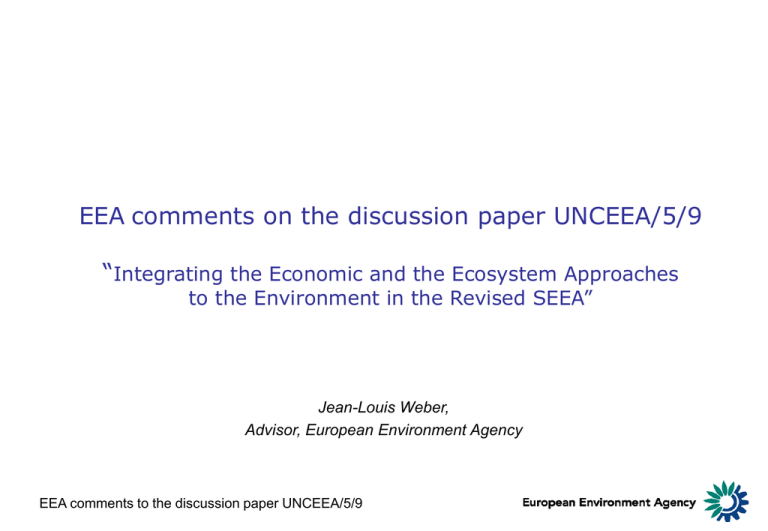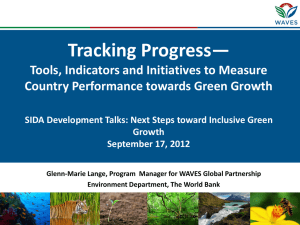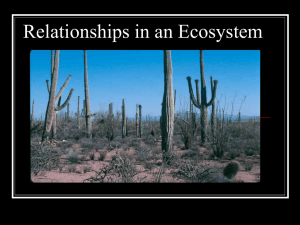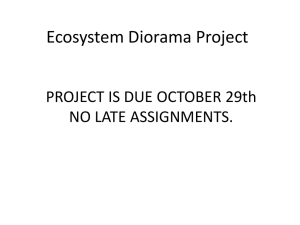Classification of ecosystem services (EEA) (UNCEEA/5/7
advertisement

EEA comments on the discussion paper UNCEEA/5/9 “Integrating the Economic and the Ecosystem Approaches to the Environment in the Revised SEEA” Jean-Louis Weber, Advisor, European Environment Agency EEA comments to the discussion paper UNCEEA/5/9 The EEA supports the overall approach • Proposal in line with EEA’s orientation, responsibility within ESEA, position taken regarding Beyond GDP and the Stiglitz report… • In line with the discussions of the Joint Seminar EEA/Management Board and Eurostat/DIMESA, Luxembourg, Nov. 24, 2009 • Ecosystem impacts as well as feedbacks at the economic and social well-being are still the missing link in the SEEA revision EEA comments to the discussion paper UNCEEA/5/9 The ecosystem issue • Ecosystems are part of the current systemic crisis: short term benefits at the expenses of long term investment, unaccounted costs, un-assessed or concealed risks, forwarding of negative impacts to others – to present or/and future generations (incomplete prices of commodities, ecological debts)… • The economy recognizes ecosystems only as a collection of (economic) resources, as free externalities and sometimes as unwanted costs (e.g. the Deepwater platform). • Risks of misleading environmental-economic decisions when resources/services are taken one by one: e.g. from REDD to REDD+ and even ++ (to avoid “biological leakage”); e.g. new debates on biofuels in Europe (possible threats to biodiversity, soil conservation and food security). EEA comments to the discussion paper UNCEEA/5/9 The basic questions Source: Roy Haines-Young EEA comments to the discussion paper UNCEEA/5/9 Policies should embrace altogether resource use and capital maintenance: man-made as well as ecosystem Biodiversity Land Water Bio-Carbon Fauna-Flora Functional Services Natural Resources Fossil energy and materials Commodities Inputs & Residuals ECOSYSTEM CAPITAL Agriculture policy Regional development Transport/ urban policies Energy policy Environmental policies EEA comments to the discussion paper UNCEEA/5/9 MAN-MADE CAPITAL Ecosystem Asset Account Accounts & indexes : e.g. carbon/biomass ecosystem accounts Bio-C balance Opening stocks by ecosystem types • Formation of bio-C (Net Ecosystem Production) • • • • • • Withdrawals by activities Net transfers between ecosystems Returns from activities Imports/Exports Storage in the user system Consumption/combustion of bio-C Sector Accounts (MFA, Supply & Use, IOT, Hybrid, Expenditures…) • • • • • • Withdrawal of bio-C Input-Output between sectors Returns of bio-C Imports/Exports Storage in the user system Consumption/combustion of bio-C Consumption of C / Emissions of CO2 CH4 • Changes due to natural & multiple causes • Change in situ bio-C storage Final stocks by ecosystem types Ecosystem C-Productivity/Health Counts • NPP trends • NDVI perturbation by activities • NDVI perturbation by hazards • NDVI perturbation by climate change • Linkage table Landscape ecological potential • Water availability (quantity*quality) EEA comments to the discussion paper UNCEEA/5/9 • Biodiversity • • • Consumption/combustion of bio-C Combustion of fossil fuel CO2/CH4 emissions Carbon Offset Expenditures • • C taxes and subsidies Purchase of C permits Virtual or Embedded C in Import-Export • Virtual or Embedded C by products Fast track implementation of ecosystem accounts in Europe by 2011/12 • Dual accounts of Ecosystems (EEA) and Economy (Eurostat) • Physical accounts firstly – although exploration of sustainable benefits accounting • 4 priority areas: Carbon [C], Land [L], Water [W] & Biodiversity [B] + embedded flows in international trade • Deadline 2011/12 with intermediate delivery by Sept. 2010 (Post-Copenhagen, Biodiversity Year, CBD COP10), then Rio+20 Economy Ecosystems PHYSICAL BALANCES Economy Ecosystems PHYSICAL BALANCES Stock Stock Natural production USE OF ECOSYSTEM RESOURCE Natural production USE OF ECOSYSTEM RESOURCE Extraction/ harvesting Extraction/ harvesting Extraction/ harvesting Extraction/ harvesting Returns/ Formation (sectors) Returns/ Formation Returns/ Formation (sectors) Returns/ Formation Final Consumption (sectors) Final Consumption Final Consumption (sectors) Final Consumption C Natural consumption Storage/Accumulation Stock … Vigour Stability, integrity Resilience Stock From resource From fossil resource EXPENDITURES Taxes, voluntary payments To land accounts W Natural consumption Storage/Accumulation EMISSIONS, RESIDUALS QUALITY/HEALTH INDEXES LINKAGE TABLES USE OF FOSSIL RESOURCE EMISSIONS, RESIDUALS QUALITY/HEALTH INDEXES From resource From fossil resource Vigour Stability, integrity Resilience EXPENDITURES Taxes, voluntary payments LINKAGE TABLES IMPORTS-EXPORTS USE OF FOSSIL RESOURCE … To land accounts IMPORTS-EXPORTS To water accounts Actual To water accounts Actual To biodiversity indexes Virtual (embedded) To biodiversity indexes Virtual (embedded) Economy Ecosystems PHYSICAL BALANCES Economy Ecosystems PHYSICAL BALANCES Stock Stock Natural production Extraction/ harvesting USE OF ECOSYSTEM RESOURCE Extraction/ harvesting L Natural production USE OF ECOSYSTEM RESOURCE Extraction/ harvesting Extraction/ harvesting Returns/ Formation (sectors) Returns/ Formation Returns/ Formation (sectors) Returns/ Formation Final Consumption (sectors) Final Consumption Final Consumption (sectors) Final Consumption Natural consumption Storage/Accumulation Stock QUALITY/HEALTH INDEXES Vigour Stability, integrity Resilience LINKAGE TABLES USE OF FOSSIL RESOURCE … Storage/Accumulation EMISSIONS, RESIDUALS From resource From fossil resource EXPENDITURES Taxes, voluntary payments To land accounts B Natural consumption IMPORTS-EXPORTS Stock QUALITY/HEALTH INDEXES Vigour Stability, integrity Resilience LINKAGE TABLES To land accounts USE OF FOSSIL RESOURCE … EMISSIONS, RESIDUALS From resource From fossil resource EXPENDITURES Taxes, voluntary payments IMPORTS-EXPORTS To water accounts Actual To water accounts Actual To biodiversity indexes Virtual (embedded) To biodiversity indexes Virtual (embedded) EEA comments to the discussion paper UNCEEA/5/9 Make it happen • • 50% of the SEEA is not really the SEEA… there is a need to move… Coarse holistic ecosystem accounts are acceptable to start, relevance matters more than accuracy: – Key selected resources/ services: balanced quantitative accounts – Ecosystem health/state accounts based on weighted indexes, continuous ex post recording of degradation • Make full use of existing information systems – Statistics… (agriculture, forestry, fishery, population, national accounts…) – Earth observation systems, satellite and in situ monitoring (GEOSS) • Start top-down: – Priority to macro assessments, physical and monetary accounts – Extension of the macro framework on the basis of experiences in voluntary countries. • Make distinction between: – Components, resources, which are additive one by one and can be addressed bottom up possible addition of individual statistics, monitoring data… – Systems which are only partly additive, partly non-additive (combinations, interactions…), and in addition which are very complex… diagnosis based on observable symptoms, top down approach as the starting point, enhanced with sampling. EEA comments to the discussion paper UNCEEA/5/9 Issues for implementing ecosystem accounts • Make a clear distinction between: – An interim accounting standard based on existing (although imperfect) data and knowledge and – Longer term research on ecological processes, ecological economics and data improvement • Mobilize data and knowledge holders in international organisations, government agencies, NGOs, science… • Possibility to agree on a very small set of priorities • Manage the scale issues, interactions between global, national and local approaches • Define clear articulations within SEEA and between SEEA (incl. ecosystems) and SNA, IPCC, future IPBES, MA, TEEB, EF… EEA comments to the discussion paper UNCEEA/5/9










